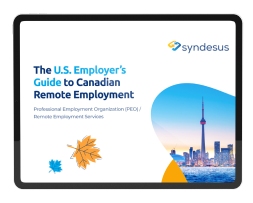Despite all the beneficial reasons to move to Canada, it’s common knowledge that tech workers in the US — especially those living in areas like NYC and Silicon Valley — earn salaries that are likely unmatched anywhere else, both within the US and in Canada.
So if the opportunity to move to Canada for work arises, it’s natural to think twice.
But it’s important to ask: do the benefits of life in Canada outweigh the slightly lower pay?
Sure, pay in Canada might be slightly lower than the major US tech hubs, but the perks of living there pay in other ways like:
- universal healthcare,
- affordable cost of living,
- an excellent education system
- and, perhaps most importantly for many in the US who were born elsewhere, a clear path to permanent residency and citizenship.
So, this article compares tech salaries and tax rates in the US and Canada and explores the benefits of Canadian social services. Let’s dive in.
Salaries differ slightly, but tax rates in the US and Canada are actually comparable
Salaries have been increasing for tech workers across North America, but the US has slightly outpaced Canada.
Still, despite the slightly lower salaries, Canada offers a myriad social benefits. Given all of the social services that Canadians receive compared to their American neighbors, many Americans believe they pay a significantly higher tax burden, but in fact, the situation is more complicated.
The Organisation for Economic Co-operation and Development (OECD) studies the tax burdens of 35 nations, including the United States and Canada.
According to its statistics, in terms of total tax revenue as a proportion of GDP, the United States collected somewhat less money from its residents in 2010, and Canada collected a slightly higher than average amount.
The US collected $11,365 USD per capita, Canada collected $14,693 USD per capita, and the average for OECD countries was $12,911 USD.
In the past, Canada and the United States swapped places, with the United States paying a somewhat higher than average cost, and Canada paying a somewhat lower than average cost. But, for the most part, both nations are near the OECD average.
The amount paid by each individual in Canada varies based on their circumstances, as Canada has a tax system like America’s, and the typical Canadian family pays a total tax rate of 24%.
The total tax rate for individuals in America also varies. On average, the top one percent of US taxpayers pay a tax rate of 31.9%, and the bottom 20% of the population pays an average of roughly 3.9% in federal and state taxes.
In terms of social services, Canadians do not pay that much more than Americans, but they receive a lot more services from their government. That’s one of the reasons why Canada is one of the world’s Top 10 happiest nations, placing seven places higher than America.
According to the Centre for Policy Alternatives, “middle-income Canadian families enjoy public services worth about $41,000 — or 63% of their income. Even households earning $80,000–$90,000 a year enjoy public services benefits equivalent to about half of their income.”
Because of the public services that their taxes pay for, the majority of Canadian homes have what many see as a better quality of life.
Canadian taxes buy residents many social benefits
So what are these benefits? Here are the social benefits that make the largest impact on Canadian life.
1. Healthcare
The US tax system differs little from that of Canada yet Canadians get universal health care while Americans don’t.
Currently, Americans pay $3.4 trillion a year for medical care and, despite the large amount spent, the United States has the fourth highest infant mortality rate in the OECD, the sixth highest maternal mortality rate, and a ninth place finish among other nations when it comes to dying at a younger age from a variety of illnesses, including heart disease and cancer.
Life expectancy in Canada is 81.7 years, putting it 11th globally, above the United States' lifespan of 78.1 (13th).
The United States has a per capita healthcare expenditure of more than $9,000. In contrast, healthcare expenditure per capita in Canada is $4,500. Life expectancy in Canada is 81.7 years, putting it 11th globally, above the United States’ lifespan of 78.1 (13th).
Overall, Canadians enjoy the same benefits that many Americans only obtain if they work for the most generous, prestigious businesses.
Some of the perks include free health care without deductibles, as well as up to 18 months of partially paid parental leave if they have children.
2. Education
Canadians have access to high-quality learning for children of all financial backgrounds. The cost of attending top-rated colleges and universities is typically much lower than comparable institutions in the United States too.
Canada’s tech industry is booming in part because education forms the foundation for the quality of tech labor in Canada.
These world-class universities, and others, graduate serious Canadian tech talent that goes on to power successful tech companies.
Several of Canada’s post-secondary schools have been rated among the world’s best universities, and the best computer science programs in Canada can be found at the University of Toronto (which is also the 17th best university in the world), the University of Waterloo, and the University of British Columbia (which is the 31st best university in the world).
These world-class universities, and others, graduate serious Canadian tech talent that goes on to power successful tech companies.
The top five tech talent cities in Canada are also the ones that produce the most tech graduates.
Montreal has three of the top 10 university-level computer science programs and produces the highest volume of tech graduates followed by Toronto, Vancouver, Waterloo Region, and Ottawa.
Tuition at Canada’s top universities is 16-38% less expensive than that of the finest institutions in the United States.
In the US, undergraduate tuition, fees, room, and board were estimated to be $17,797 at public institutions and $46,014 at private nonprofit institutions. In Canada, the average annual tuition at a public college in 2021 was $7,938 Canadian dollars or $6113 US dollars.
3. Immigration
Canada’s immigration laws have long valued immigrants who are well-educated and highly qualified.
The Global Talent Stream (GTS) program was designed to expedite and ease the processing time for visa and work permit applications for foreign nationals who possess unique talents or are highly skilled. GTS is similar to the H-1B, but in many ways, significantly better.
For example, a typical H-1B processing time is three months to one year for approvals. Now, compare that to GTS which takes 10 business days to assess applications and 14 business days to process work permits for qualified workers.
Currently, Canada prioritizes young, highly-skilled workers with Canadian experience for permanent immigration.
Another GTS perk is that once you’re a permanent resident, which can take less than a year, you can become a Canadian citizen in just five years. If you’ve lived in Canada for at least 1,095 days out of five years you could be one of the thousands of new citizens Canada welcomes each year.
On the other hand, some H-1B visa-holders wait years — even decades — for their Green Cards. Children of foreign nationals who came to the US legally and applied for their Green Cards are now finding out that they can’t get permanent residency through their parents because they are too old by the time the green card comes.
Currently, Canada prioritizes young, highly-skilled workers with Canadian experience for permanent immigration, and is aiming to welcome over 300,000 new immigrants each year, so participating in GTS is a smart way to set yourself up for a future in Canada.
Canada’s global reputation for being the most welcoming country to migrants – there’s even data to back that claim up. Feeling safe and welcome in a new country is important for immigrants who plan to take root.
It’s also important to note that Canada is an easy option for tech workers and founders leaving Silicon Valley. Canada and the US share time zones, and it’s geographically easier to cross the border for meetings.
Ready to live and work in Canada? We can help.
As you can see, despite the slightly lower salaries in Canada, moving to Canada from the US for a tech job has a lot of benefits, especially for individuals who are in the US on an H-1B visa or who are waiting for years for their permanent residency.
Whether you want to take your American job to Canada or start fresh with a new tech job, we can help.
It’s possible to keep your US job and work remotely in Canada with a little help from a PEO. A Canada-based PEO — like Syndesus — enables a US-based company to remotely hire workers in Canada without needing to have a Canadian office.
Want a new job in Canada? Path to Canada helps foreign-born tech workers explore Canadian jobs and connects them with Canadian tech companies willing to sponsor their work visa.
We also help Canadian tech companies find experienced technical talent who are seeking to move permanently to Canada. We pre-qualify applicants so you only interview the very best global talent.
Are you looking for a tech job in Canada or are you a Canadian company seeking qualified candidates? Visit our website to learn more about how we can help you, or join our database of qualified candidates seeking to move to Canada!




